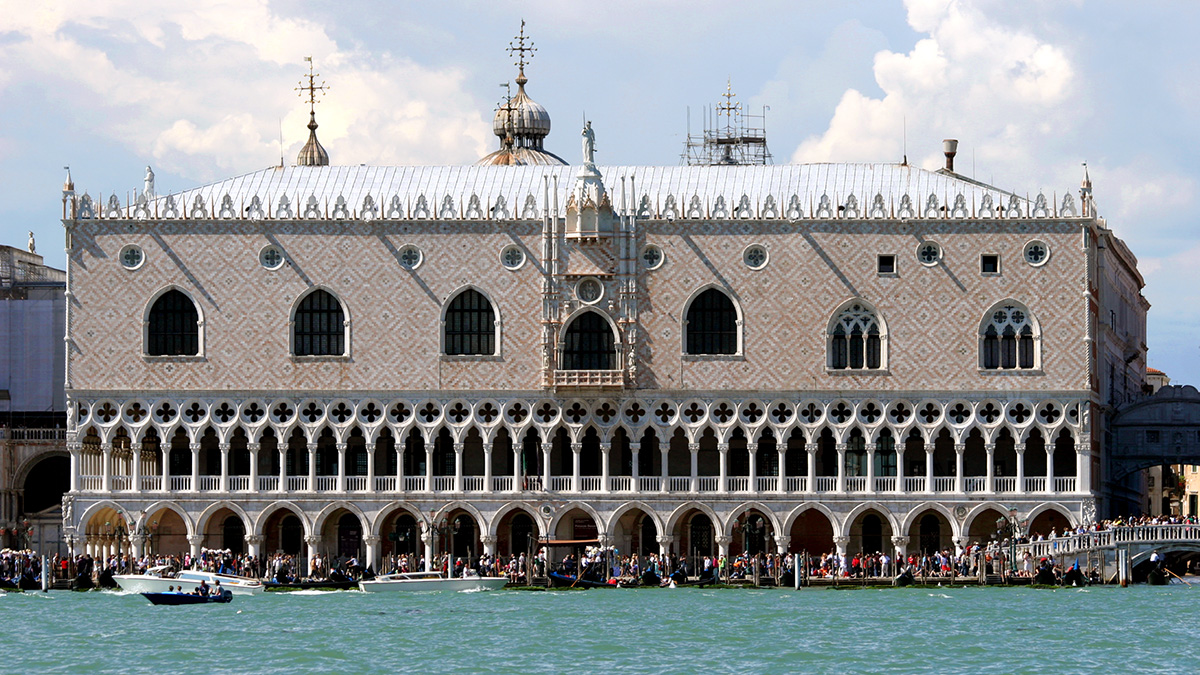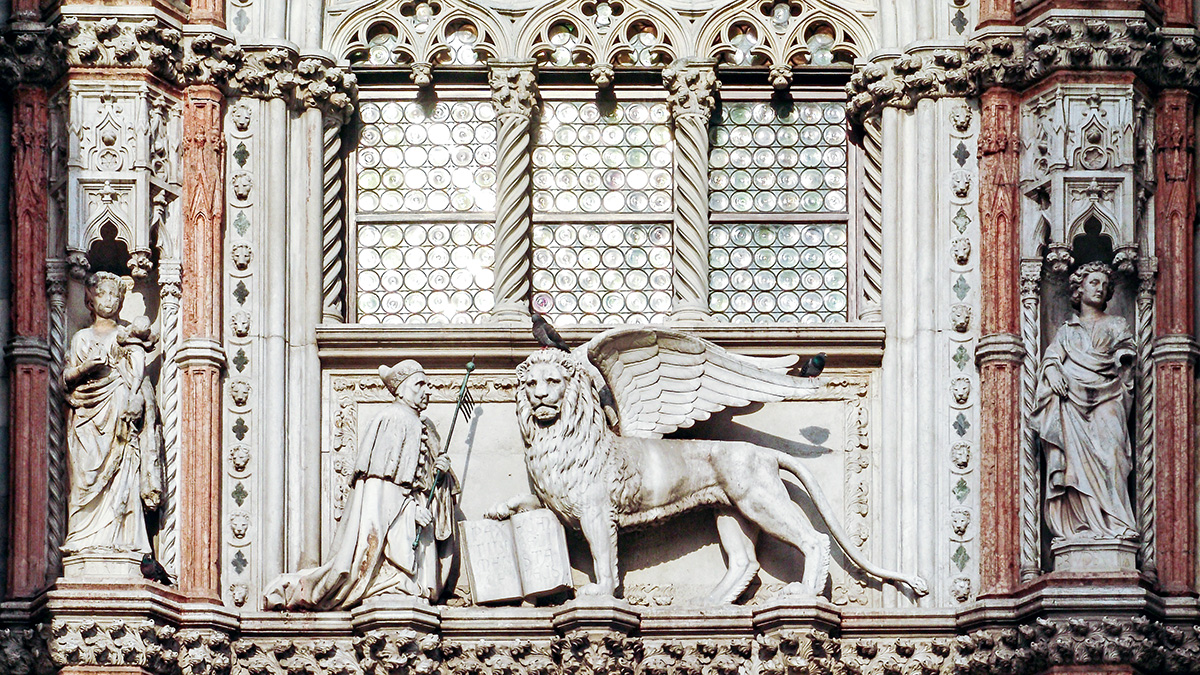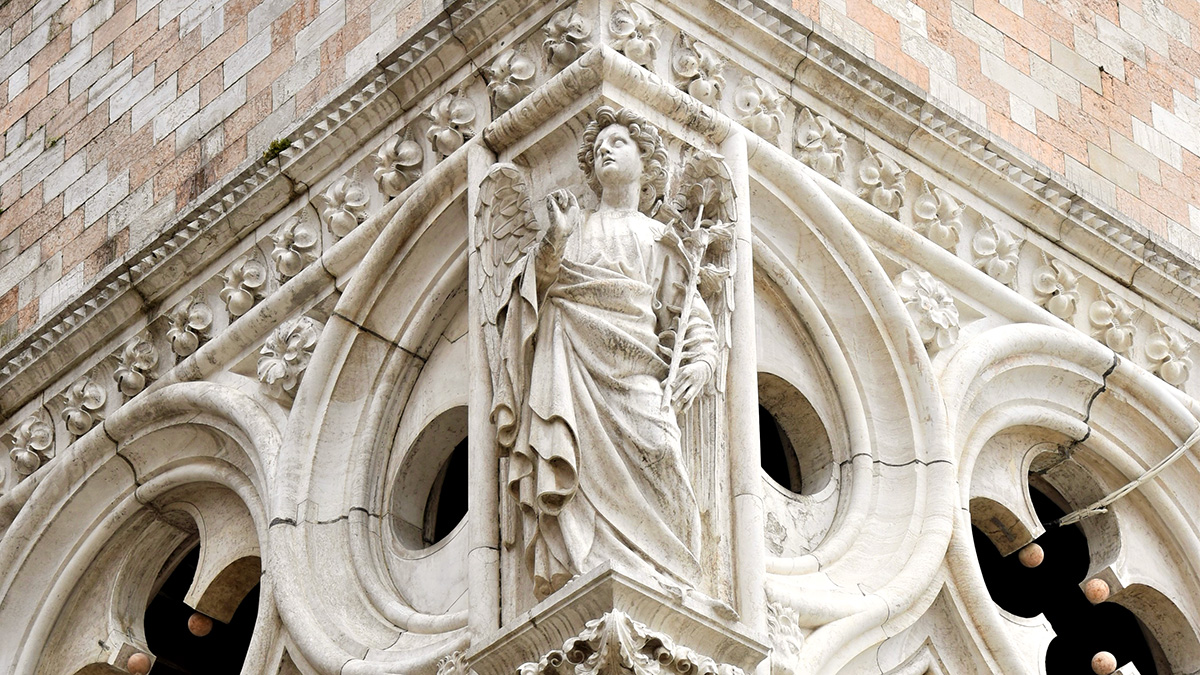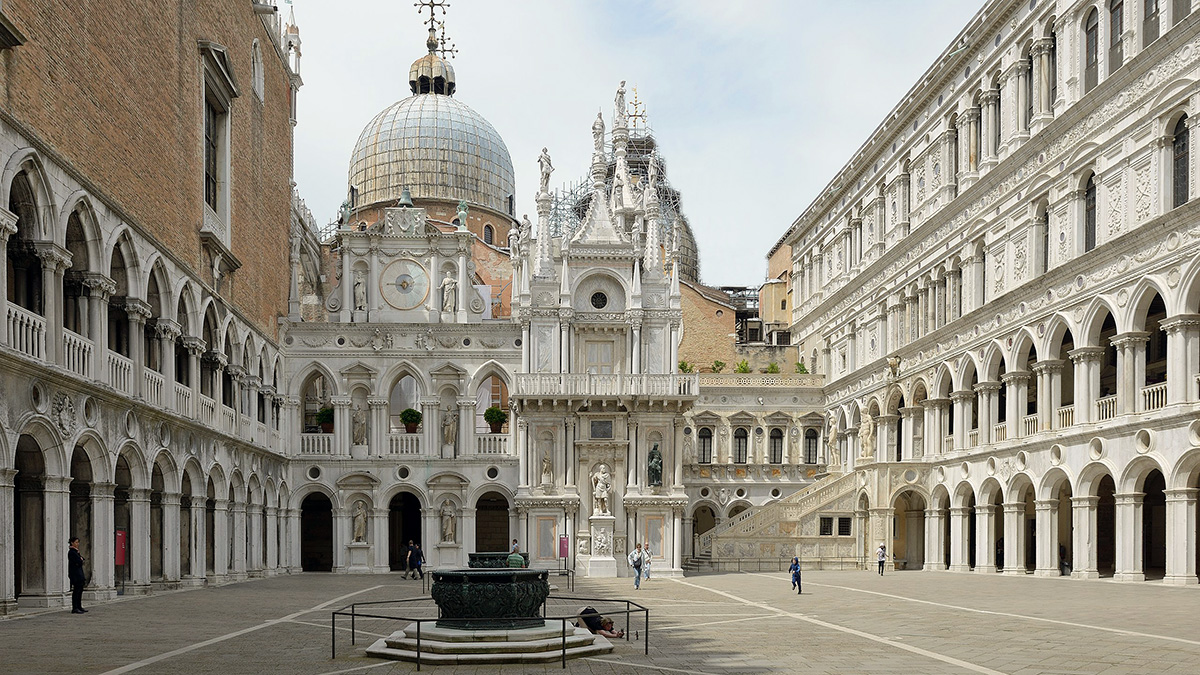The Palazzo Ducale is a gothic palace that was the residence of the Doge of Venice. Its two most visible façades look towards the Venetian Lagoon and St Mark's Square, or rather the Piazzetta.
The Palace is the very symbol of Venice, in St. Mark’s Square, near to the famous Ponte dei Sospiri. Inside, works by great masters as Tintoretto, Veronese, etc.
Venice Doge's Palace Reserved Entry
The current palace was largely constructed from 1309 to 1324, designed perhaps by Filippo Calendario. It replaced earlier fortified buildings of which relatively little is known. Giovanni and Bartolomeo Bon created the Porta della Carta in 1442, a monumental late-gothic gate on the Piazzetta side of the palace. This gate leads to a central courtyard.
The palace was badly damaged by fire in 1574. In the subsequent rebuilding work it was decided to respect the original Gothic style, despite the submission of a neo-classical alternative design by the influential Renaissance architect Andrea Palladio. However, there are some classical features — for example, since the 16th century, the palace has been linked to the prison by the Bridge of Sighs.
As well as being the ducal residence, the palace housed political institutions of the Republic of Venice until the Napoleonic occupation of the city. Venice was ruled by an aristocratic elite, but there was a facility for citizens to submit written complaints at what was known as the Bussola chamber.

The building is preserved as a museum. Inside, the visitor can see paintings by Tintoretto and Paolo Veronese, which glorify the Venetian state.
Don't miss the guided tour named Secret Itinerary, which will let you discover the part of the palace where the city's administration worked, as well as Casanova's jail and the wonderful five hundred year old roof structure. Inside the palace, visitors can view the Great Council Hall, the Chamber of the Council of Ten, the torture chamber, prison cells and other rooms. The famous Bridge of Sighs connects the Doge's Palace with the state prisons.
Doge's palace opening times
- From April 1st to October 31st: Open daily 09:00 - 19:00. Last admission 18:00.
- From November 1st to March 31st: Open daily 09:00 - 18:00. Last admission 17:00.
- Closed on December 25th and January 1st.
Map of the Doge's Palace
AddressPiazza San Marco
30124 Venezia, Italia

Facades of the Doge's Palace
The Doge's Palace extends over three wings around the sides of a large central porticoed courtyard, the fourth side of which is formed by the body of the Basilica Marciana, the former chapel of the palace.
The entire construction rests, as is the case with most Venetian buildings, on a platform made of larch trunks, which in turn supports a large slab of Istrian stone. The main façades, facing St. Mark's Square and facing the lagoon, have similar dimensions, since the one facing the lagoon is 71.5 metres long and has 17 arcades, while the one in the piazzetta, with one more arcade, measures 75 metres. A third facade looks out onto a canal known as the rio di Palazzo, which runs through the Ponte dei Sospiri (Bridge of Sighs) and empties into the lagoon at the Ponte della Paglia (Straw Bridge).
The two main facades of the building, in Gothic-Venetian style, which overlook the piazzetta and the quay, are developed on two levels of colonnades on which rests a powerful body with inlaid red and white marble in which large pointed windows open, with a monumental central balcony richly decorated, and with a crown where small pinnacles and openworked cornices alternate in place of the traditional cornice. Overall, the decoration presents a clear reference to oriental architectural styles and, to a lesser extent, to Germanic, derived largely from the high number of cultural and commercial contacts that Venice had with other Mediterranean and European peoples and the subsequent importation of materials from those lands.
The ground floor arcade, with pointed arches and columns without a base; this portico was not formerly walled up, so that communications were open on all sides and the columns rested on their pedestals; but frequent flooding forced the floor of the square to be raised, and the pedestals were buried, which has a bad effect on the body of the building.

Porta della Carta of the Doge's Palace
The main door of the Doge's Palace, located between the palace and the basilica, is the Porta della Carta, literally Paper Portal, which dates back to the time of Doge Foscari.
The Porta della Carta has a very rich sculptural and decorative apparatus, originally painted and gilded. On the two pinnacles on either side are the figures of the cardinal virtues and to crown the door is a bust of St. Mark topped by the figure of Justice with her scales and sword. The central element of the door is the representation of Doge Francesco Foscari kneeling before the lion of St. Mark, in a new sculpture from the 19th century to replace the original destroyed by the French in 1797.
The monumental Porta della Carta was built in floral Gothic style by Giovanni Bon, his son Bartolomeo Bon and other artists from the city. Some critics attribute the statues of the virtues to Antonio Bregno or to Giorgio da Sebenico.
Entering through the Porta della Carta, one passes through a short corridor that leads to the inner courtyard of the palace. The corridor ends at the Arco Foscari, which is also attributed to the Dalmatian artist Giorgio da Sebenico. The entrance is dominated by the monumental Scala dei Giganti.
It is not known why the gate is called Porta della Carta (Paper Gate). Various explanations have been given for this: it owes its name to the custom of publishing laws and decrees there, or to the presence of public scribes there, or to the fact that the state archives were located nearby. There is no consensus among scholars on this.

Sculptural groups of the Doge's Palace
External sculptural groups adorning the corners of the façades of the Doge's Palace in Venice. The sculptures on the corners of the façade overlooking the lagoon are attributed to Filippo Calendario or to Lombard artists such as Raverti or Bregno.
At the corner between the façade overlooking the canal and the façade on the rio di Palazzo there are two superimposed sculptural groups representing:
- Above: the Archangel Raphael in the act of blessing and Tobias.
- Below, on the Ponte della Paglia: The biblical episode of Noah's drunkenness where the trunk of the vine situated at the corner divides the scene into two parts. Towards the sea is the figure of the old man Noah, naked and staggering, while towards the canal are the two sons, one of whom covers his father's nakedness with a cloth.
At the opposite end of the façade, towards the Piazzetta, are depicted:
- Above: The Archangel Michael with his sword drawn.
- Below: Adam and Eve in a rigid frontal position, separated by a fig tree around which the serpent with the face of the devil coils. Eve holds the fruit of sin, which she points to with her other hand.
On the façade towards the Piazzetta, at the corner towards the Porta della Carta, the sculptural group represents the Judgement of Solomon and the Archangel Gabriel, attributed to Bartolomeo Bon.
The three archangels depicted on the two main facades play an important propaganda role: Gabriel in the north-west corner symbolises Politics, Michael in the south-west corner symbolises War and Raphael in the south-east corner symbolises Commerce.
In the centre of the façade overlooking the lagoon, there is the central balcony of the Great Council Hall, the work of the brothers Jacobello and Pierpaolo dalle Masegne, built between 1400-1404. It is surrounded by two important octagonal pillars, interrupted by niches and topped by pyramids. Six statues are lined up along the pillars, the lower ones represent St Theodore and St George (the latter a work of Giovanni Battista Pellegrini), the upper ones represent Temperance, Justice, Fortitude and Prudence. Above the arch there is an oculus containing a representation of Charity. From the inscription it can be deduced that the work was created under the direction of Michiel Sten. Above the oculus, placed on a shelf, is a Martian lion. Above it, in niches, are the statues of St. Mark, St. Peter and St. Paul. The balcony is crowned by a statue of Justice by Alessandro Vittoria.
On the façade facing the Piazzetta, on the thirteenth column of the loggia, stands the enthroned Justice. The balcony in the centre of the upper order, with the Lion of St Mark, dating from 1531-1538, was designed by Sansovino. On either side of this structure are two niches with statues of Mars and Neptune. The upper panel contains a copy of the sculptural group depicting Doge Andrea Gritti and the Lion of St Mark, destroyed during the French occupation in 1797 and rebuilt in the 19th century. It is framed by two statues, one representing Mercury and the other Jupiter. At the top, a statue representing Venice by Alessandro Vittoria.

Courtyard of the Doge's Palace in Venice
The Doge's Palace extends over three wings around the sides of a large central porticoed courtyard, the fourth side of which is formed by the body of the Basilica Marciana, the former chapel of the palace.
Currently, access to the palace is via the Porta del Frumento (Gate of the Wheat) located in the south wing of the building, opposite the bacino di San Marco. The gate was so named because it was next to the Ufficio delle Biade. Walking along the entrance corridor, you reach the courtyard, where the unitary appearance that the palace presents from the outside is lost and we can discover the successive interventions that have taken place over four centuries (from the mid-14th century to the beginning of the 17th century).
The courtyard is completely surrounded by a portico on which rests a loggia reproducing the external layout of the building. The façades overlooking the courtyard were built during the dogeship of Marco Barbarigo and Agostino Barbarigo, that is, between 1485 and 1501 (the dating is precise since the coats of arms of both doges are present), while the two inner façades to the south and east, both made of brick, retain the characteristic Venetian Gothic appearance of the corresponding outer façades. The eastern façade of the courtyard, towards which the monumental staircase leads, is characterized by a Renaissance-style marble decoration, designed by the architect Antonio Rizzo, a consequence of the radical reconstruction of that wing following the voracious fire of 1483. It is structured in four orders: the first with orthogonal pilasters supporting semicircular arches, the second with columns and pointed arches, while the upper floors are adorned with a very refined relief decoration with Renaissance motifs, carried out at the end of the 15th century. Quattrocento by Pietro Lombardo and his sons Antonio and Tullio.
The fourth side of the courtyard, to the north, borders St. Mark's Basilica and is occupied by the Porticato Foscari. It ends with the majestic Arco Foscari, a semicircular arch made of white Istrian stone and red Verona marble in the second half of the Quattrocento, while on its south side is attached the small clock facade, made in the 17th century by Bartolomeo Manopola and decorated with ancient sculptures from the Roman era. Opposite the Arco Foscari is the monumental staircase known as the Scalone dei Giganti (Giants' Staircase).
This courtyard was used for the coronation ceremonies of the Doge, tournaments and an annual bull hunt. The courtyard is dominated by two wellheads for supplying water to the complex, the Alberghetti well and the Nicolas de'Conti well, masterpieces of Mannerist sculpture in bronze. The paving in trachyte and marble elements copies that of the exterior of the square.



